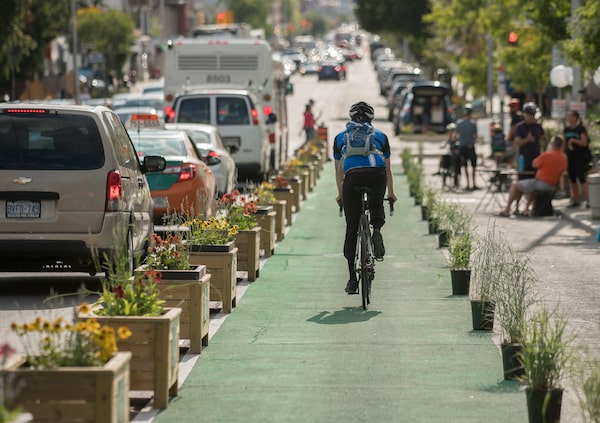
A cyclist rides down a bike lane on Danforth Avenue between Woodbine and Woodmount Avenues in Toronto on August 23, 2019.J.P. MOCZULSKI
A significant milestone in bicycle safety was lost in the flurry of news that followed British Prime Minister Boris Johnson’s undoing. Transport for London (TfL) has begun to use closed-circuit television (CCTV) cameras to fine vehicles caught “driving in mandatory cycle lanes and cycle tracks.” TfL runs the day-to-day operation of London’s public transport network and manages the city’s main roads.
According to the Daily Mail, motorists can be fined £130 ($200) “for placing a wheel in a cycle lane or edging into a box junction while in traffic. Transport for London and local councils have been given new powers from the Government to enforce moving traffic violations that had previously been the responsibility of the police.”
While the Daily Mail decried a “war on motorists,” cyclists celebrated what they consider an enormous leap forward. Cycling in the U.K. increased dramatically during the pandemic and is continuing to rise owing to the high price of fuel.
In the same way that Johnson impeded the movement of good ideas through British parliament, parking in the bike lane impedes bicyclists.
“Vehicles driving in cycle lanes put cyclists in danger and can deter people from choosing to cycle,” said Tom Bogdanowicz, senior policy and development officer for the London Cycling Campaign, in a TfL statement. “That’s why it’s crucial that investment in cycling provision is backed up with camera enforcement, just as camera enforcement is used to keep bus lanes clear. We welcome TfL’s use of new enforcement powers do this. It will reduce road danger and further enhance the great value for money that investment in the cycling network brings.”
Should Canadian cities be following suit?
To many who commute on two wheels the subject is not open for debate. Anything that can increase safety and encourage more people to cycle is worth it. But using CCTV to police our roads and bike lanes has its costs. Namely, our privacy.
According to an IHS Markit report published in Comparitech.com, a website that provides insights and reviews of cyber security and privacy online, there are more than a billion CCTV cameras worldwide and more than half of those are in China. London, in the top 10 for most “surveilled” cities in the world outside China, has about 127,000 cameras for 9.5 million people, a rate of 13.35 cameras per 1,000 inhabitants. By comparison, Toronto has about three CCTV cameras per 1,000 people. Comparitech’s research “found little correlation between the number of public CCTV cameras and crime or safety.”
London’s CCTV proliferation has a long history. In 1960, London Metropolitan Police used CCTV as a temporary measure to monitor crowds celebrating the arrival of the Thai royal family. In 1961, CCTV served as a temporary means to police vandalism of a London Transport station. By the 1970s, it was being used to monitor traffic and by the 1980s it was used to prevent crime on council estates. CCTV played a vital role in the construction of the “Ring of Steel” following the 1993 IRA bombing in Bishopsgate. In the U.K., there are more than 5.2 million CCTV cameras in operation. The country is awash in them. So, using them to discourage motorists from parking in bike lanes makes little difference. If you are walking, driving or cycling in London, chances are you are being filmed. Why not use it to curb drivers parking in bike lanes?
CCTV surveillance is less prevalent in Canada. It’s also less accepted. In July 2021, the Ontario provincial government announced it was budgeting an additional $2-million to expanding CCTV systems. This move was met with trepidation by the Canadian Civil Liberties Association (CLLA). In April 2022, Vancouver city council killed a motion to install cameras to prevent violent crime by a vote of eight to one. The sacrifice of privacy was not deemed worth any potential safety benefits.
“There’s a ton of data out there from countries like the U.K. where they’ve been using this method for decades, that shows that any deterrence effective is very short lived and very minimal,” said Brenda McPhail, director of the CCLA’s privacy, technology and surveillance program.
That’s a big issue when considering the use of CCTV to police bike lanes. We do not know how effective it will be, but we can be certain that privacy will be lost. Do we want to live in a community defined by constant and pervasive street-level surveillance? CCTV cameras don’t turn off when crimes or infractions aren’t being committed. They don’t turn on the minute a minivan blocks a bike lane, they film everything all the time, including lawful citizens living their lives.
That a city as large and complex as London is willing to use CCTV to stop automobiles driving and blocking bike lanes, demonstrates how damaging these infractions can be. “While most motorists do follow the rules, enforcement is a good deterrent for those who put other road users at unnecessary risk,” said Hackney Mayor Philip Glanville, London councils’ climate change, transport and environment lead. “By making roads safer across the capital and having the powers to enforce on critical cycling and walking routes, we can increase opportunities for active travel.”
Who knows, we may get a new motto: Safety First. Privacy Last.
 Andrew Clark
Andrew Clark